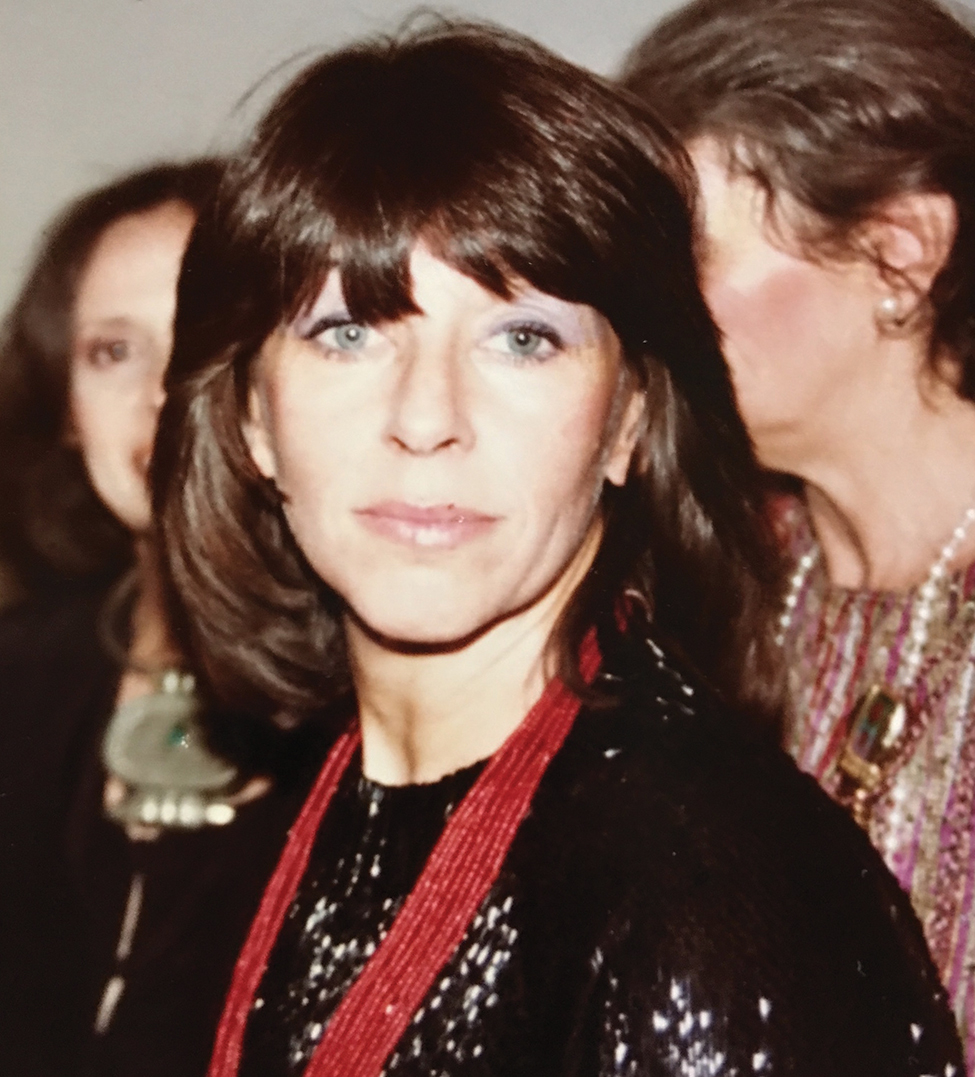Ellen and Richard Sandor’s Art Obsession

BY KEVIN NANCE
As young collectors, Ellen and Richard Sandor started out slowly. “We were kids, and we both have a collector gene in us,” Richard recalls in a recent interview at their Gold Coast apartment. “We bought lithographs for $10 or $15.” His wife shrugs. “To be honest, it wasn’t anything more than a young couple who wanted something on the wall,” she says. “The obsession did not occur until 1978, when we bought this apartment.”
Obsession? A strong word, that.
“Just look around,” Ellen Sandor says. And you see what she means.

The Sandors’ Astor Street home—a 6,700-square-foot gallery-like space that features marble pillars from the old Palmer Potter mansion—is bulging with art, including about 1,600 works in photography, sculpture and new media. Photographs take pride of place, hung closely together, salon-style, in vertical arrays that almost reach the first floor’s 18-foot-high ceiling.
There are images that represent the different eras of photography, from its beginnings in the mid-19th century to the golden age of photojournalism (including classic prints by Walker Evans, Margaret Bourke-White, Henri Cartier-Bresson, Dorothea Lange and others) to 1970s celebrity portraiture (much of it by Richard Avedon) to postmodernism (Richard Prince, Cindy Sherman) to contemporary work by international artists such as Ai Weiwei.
At first glance, the display can feel dizzyingly chaotic, with sculpture and new-media work juxtaposed with the photographs. But there’s method—and, yes, a certain obsessiveness—to the seeming madness. The photographs are grouped by subject: French; American history (including a print of the flag being put into place on Iwo Jima, signed by the survivors); Czech modern; African-American; fashion; science; architecture; and on and on.

And the juxtapositions, which initially may have seemed arbitrary, begin to make sense. A photograph of Picasso by his lover, Dora Maar, is accompanied by another image in which subject and photographer switch roles; you can see Picasso’s shadow creeping in from the side. There’s not one but two prints of Rodin with his famous sculpture “The Thinker”—a silver print and a gravure, the latter more valuable—plus, of course, a Rodin sculpture. There are multiple images of the Italian sculptor Giacometti, including one by Cartier-Bresson in which the artist looks much like one of his famously elongated artworks. There are works by Toulouse-Lautrec as well as a rare photograph of the artist himself, diminutive and droll.
“It all matches,” Richard Sandor says with satisfaction. “It’s all related.”
“The beautiful thing is that the photography is displayed with paintings and sculpture and new media,” his wife adds. “It took a while for Richard to get comfortable with it, but by the ’90s, we were juxtaposing everything. He loved clustering various things.”
In the early years and even much later, the Sandors’ unusual way of displaying their collection struck some visitors as, well, odd. “People looked at it and said, ‘Jesus, you shouldn’t be presenting it like this,’” Richard Sandor says. “No one is going to do what we do,” his wife adds with a shrug. “Very few people, anyway. But the pairing of different media is what’s happening now. Even the museums are starting to catch on.”
*
This magnificent obsession, one of the most impressive and eclectic private collections in the world, is the result of the artistic passions of Ellen Sandor, an accomplished new-media artist in her own right, and the curatorial rigor of Richard Sandor, a leading economist at the University of Chicago.
“When we started, I wanted Richard to share my passion for art,” says Ellen Sandor, who received her degree in sculpture from the School of the Art Institute of Chicago and has long been a pioneer in virtual photography and virtual-reality art. “I knew that he had the historical research impulse inside him. I wanted him to be obsessed, and sure enough, it worked.”
It worked in part because her husband, who knew a thing or two about undervalued investments, saw that photography was in the early stages of an upswing. It had struggled for years to gain acceptance in the art world—only a handfull of museums around the globe devoted space to the medium—but was beginning to appear in small auctions at Sotheby’s and elsewhere.
“Photography was not really considered fine art, and to us that seemed absurd,” Richard Sandor says. “But it was great value, so in 1980, I went to Sotheby’s and publicly bought a bunch of things and paid top prices, like $2,000 to $5,000. I stood up and kept on paying, because I wanted to be a marked man. From that day on, every dealer said, ‘There’s a new collector, he’s crazy, he’s paying thousands for pieces as opposed to hundreds.’ So when every dealer would hit Chicago, I got first dibs. And during the 80s, we were probably the principal buyers of photographs at Sotheby’s and Christie’s.”
In the end, his economist’s insight served the Sandors well. “Photography has grown about as fast as computers: 18 percent, compounded for 40 years,” he says with a smile. “We were fortunate.”
It wasn’t just the chance to invest in photography, or even his wife’s urging him on, that appealed to Richard Sandor. It was the chance to amass a collection that, if not exactly encyclopedic, could encompass the entire history of the art form.
“You can’t see the span of art, but you can clearly see the span of photography, which began in the 1830s,” he says. “You get a grip on it. We didn’t set out to do it this way, but the collection defined itself. There’s a timeline to follow that leads you from one thing to the next. And if you’re obsessive-compulsive, as we are, that’s what you do.”
Catherine Edelman, owner of her eponymous photography gallery in River North, calls the Sandor collection one of the most historically complete, and most uniquely displayed, that she knows of.
“I’ve never seen another collector install in that fashion, but the Sandors have come to understand that when placed appropriately, the images start to tell a story about the history of photography,” Edelman says. “They’ll buy the same image in many different incarnations, including a vintage and then a modern print, because they like to see how the photographer sees that image over time. Or they’ll have a famous image and then a print of the next frame on the photographer’s roll of film—something that informs the well-known image. It’s very informative and interesting, and they’re very invested in doing this extra level of research. As a result, their collection is like no other I’ve ever seen.”
Over time, as the Sandors themselves realized just how unique their collection is, they’ve begun to allow it to be seen by others. For years, Richard Sandor resisted, preferring to share the collection only with friends and small groups associated with the Art Institute. But as always, his wife wore him down. “She said, ‘We’ve got stuff from 1840 to new media. We can’t keep it all to ourselves. We have to open it up.’ And she was right. It’s been a satisfying experience for us to share.” Now the collection is frequently on display to groups organized by major museums around the world, including the Metropolitan Museum of Art and the Museum of Modern Art, as well as during EXPO Chicago, the city’s annual international contemporary art fair.
“It’s a world-renowned collection with several very expensive pieces, so it shows the maturity of the Sandors when they open up their home,” Edelman says. “When you’re doing something at the level they’re doing it, you realize you’re the temporary owners of something much larger than yourselves and that you’re obligated to share it. They’re great citizens in that sense.”
“I’ve met dozens of serious photo collectors, and Ellen and Richard are the most knowledgeable members of the species,” says the Chicago photographer Art Shay, who has several images—including a print of his famous picture of Simone de Beauvoir standing nude in Nelson Algren’s bathroom—in the Sandor collection. “The walls of their vast Chicago apartment could serve as a history of the growth and burgeoning of the photographic art. The eye is caught by two historic Diane Arbuses, Cartier-Bressons galore, the most famous Dorothea Lange, etc. They are absolutely world class.”
The Sandors, by the way, are not done collecting. Although nearly every inch of space in their apartment appears to be accounted for, “They just keep adding,” Edelman says. “Which is just phenomenal.”
And just a wee bit obsessive? Absolutely. The Sandors wouldn’t have it any other way.
Follow Kevin Nance on Twitter @KevinNance1






